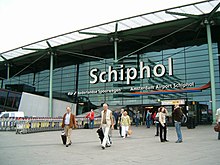
The Netherlands is both a very densely populated and a highly developed country in which transport is a key factor of the economy. Correspondingly it has a very dense and modern infrastructure, facilitating transport with road, rail, air and water networks. In its Global Competitiveness Report for 2014-2015, the World Economic Forum ranked the Dutch transport infrastructure fourth in the world.

GVB is the municipal public transport operator for Amsterdam, the capital of the Netherlands, operating metro, tram, bus and ferry services in the metropolitan area of Amsterdam.

The Amsterdam Metro is a rapid transit system serving Amsterdam, Netherlands, and extending to the surrounding municipalities of Diemen and Ouder-Amstel. Until 2019 it also served the municipality of Amstelveen but this route was closed and converted into a tram line. The network is owned by the City of Amsterdam and operated by municipal public transport company Gemeente Vervoerbedrijf (GVB) which also operates trams, free ferries and local buses.

The Damrak is an avenue and partially filled in canal at the centre of Amsterdam, The Netherlands, running between Amsterdam Centraal in the north and Dam Square in the south. It is the main street where people arriving at the station enter the centre of the city. Also, it is one of the two GVB tram routes from the station into the centre, with lines 4, 9, 16, and 25 running down it. It is also on the route of the North/South Line being constructed between the existing metro station at Centraal Station and the new Rokin station.

Amsterdam Zuid is a railway station situated in the borough of Amsterdam-Zuid in Amsterdam, Netherlands. For a number of years, it was named Amsterdam Zuid WTC, in reference to the neighbouring World Trade Center Amsterdam. During 2006, in conjunction with the rapid development of the area surrounding the station, the station was enlarged and the reference to the WTC was formally dropped from the name.

Amsterdam Centraal station is the largest railway station in Amsterdam, North Holland, the Netherlands. A major international railway hub, it is used by 192,000 passengers a day, making it the second busiest railway station in the country after Utrecht Centraal and the most visited Rijksmonument of the Netherlands.

Den Haag Centraal is the largest railway station in the city of The Hague in South Holland, Netherlands, and with twelve tracks, the largest terminal station in the Netherlands. The railway station opened in 1973, adjacent to its predecessor: Den Haag Staatsspoor, which was subsequently demolished. It is the western terminus of the Gouda–Den Haag railway.

Amsterdam Sloterdijk is a major railway junction to the west of Amsterdam Centraal station. It is at a rail-rail crossing, with an additional chord (Hemboog). It is on the railway line from Amsterdam Centraal to Haarlem and the last station before the junction where the line Amsterdam Centraal-Zaandam diverges from it and on the crossing west branch of the Amsterdam–Schiphol railway line between Schiphol and Amsterdam Centraal.

Tramlijn 5 is a tram line operating between Amsterdam and Amstelveen in the Netherlands. Operated by the municipal transport company GVB, the route normally runs between Van Hallstraat in Amsterdam and Stadshart in the neighbouring municipality of Amstelveen. Tram line 5 connects several important areas of the city, including the Zuidas financial district and Leidseplein, and also provides a rapid tram route south of Amsterdam Zuid station to Stadshart, Amstelveen's town centre.

The Amsterdam Tram is a tram network in Amsterdam, Netherlands. It dates back to 1875 and since 1943 has been operated by municipal public transport operator Gemeentelijk Vervoerbedrijf (GVB), which also runs the Amsterdam Metro and the city bus and ferry services. Amsterdam has the largest tram network in the Netherlands and one of the largest in Europe.
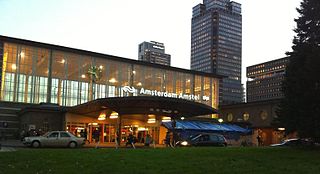
Amsterdam Amstel is a railway station in Amsterdam, Netherlands. The station opened in 1939. It is located to the southeast of Amsterdam Centraal in the borough of Amsterdam-Oost, near the Amstel river. Amsterdam Amstel is used daily by 50,000 train and metro passengers. Rail services at the station are provided by NS, the principal railway operator in the Netherlands. Metro, tram and city bus services are provided by municipal operator GVB. Regional buses are operated by Transdev and Keolis.
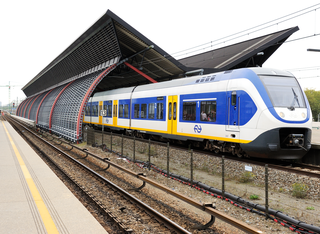
Amsterdam RAI is a railway station situated in southern Amsterdam, Netherlands. It is located between the two directions of the A10 Amsterdam ring road. It is also a metro station at which GVB runs two lines. The station takes its name from the nearby RAI Amsterdam Convention Centre.

Amsterdam Lelylaan is a railway, metro, tram and bus station in west Amsterdam. It is served by trains of the Nederlandse Spoorwegen and metros of the GVB. The station opened on 1 June 1986. It is located on the Amsterdam-Schiphol railway, a few km south of Amsterdam Sloterdijk railway station. South of this station, trains turn west towards Schiphol railway station, while metros turn east towards Amsterdam Zuid railway station. The station is located in the Amsterdam borough of Slotervaart, on a long viaduct spanning three roads.
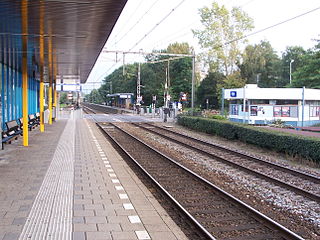
Diemen is the main railway station of the municipality of Diemen, Netherlands. It is located on the Amsterdam–Zutphen railway between Amsterdam Science Park and Weesp. The station was first opened in 1882 and then closed in 1929. It was reopened at the same location in 1974. The station building was completed in 1978. The train services are operated by Nederlandse Spoorwegen. Among the direct destinations are Almere, Amersfoort, Amsterdam Centraal, Hilversum, Lelystad, and Zwolle. There are connections to two bus services operated by GVB.

Diemen Zuid is a railway station is located in Diemen, a city to the southeast of Amsterdam. The railway station is served by Nederlandse Spoorwegen (NS) services as well as line 53 of the Amsterdam Metro.

Rotterdam Blaak is a railway and metro station in Rotterdam, Netherlands. Located in the centre of the city, not far from the cube houses and the Markthal, the station is served by trains operating on the Breda–Rotterdam railway between Rotterdam Centraal and Dordrecht.
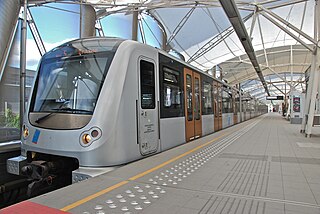
Brussels has an extensive network of both private or public transportation means. Public transportation includes Brussels buses, trams, and metro, as well as a set of railway lines and railway stations served by public trains. Air transport is available via one of the city's two airports, and boat transport is available via the Port of Brussels. Bicycle-sharing and car-sharing public systems are also available. The city is relatively car-dependent by northern European standards and is considered to be the most congested city in the world according to the INRIX traffic survey.
The main public transport in the Netherlands for longer distances is by train. Long-distance buses are limited to a few missing railway connections. Regional and local public transport is by bus, and in some cities by metro and tram. There are also ferries.
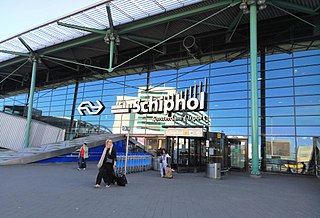
Schiphol Airport railway station is a major passenger railway station in Haarlemmermeer, Netherlands, beneath the terminal complex of Amsterdam Airport Schiphol, operated by the Nederlandse Spoorwegen. The station's six platforms are accessible via twelve escalators and three elevators located in the main concourse of the airport. The original station was opened in 1978, and the current station in 1995. It connects the airport to Amsterdam and other cities in the Netherlands, as well as to Belgium and France.

Rokin metro station is an Amsterdam Metro station on Line 52, the fifth and newest metro line in Amsterdam which connects the Amsterdam-Noord (north) borough to the Amsterdam-Zuid (south) via Amsterdam Centraal. It began service in July 2018 and is under the Rokin canal in Amsterdam, Netherlands.
.



